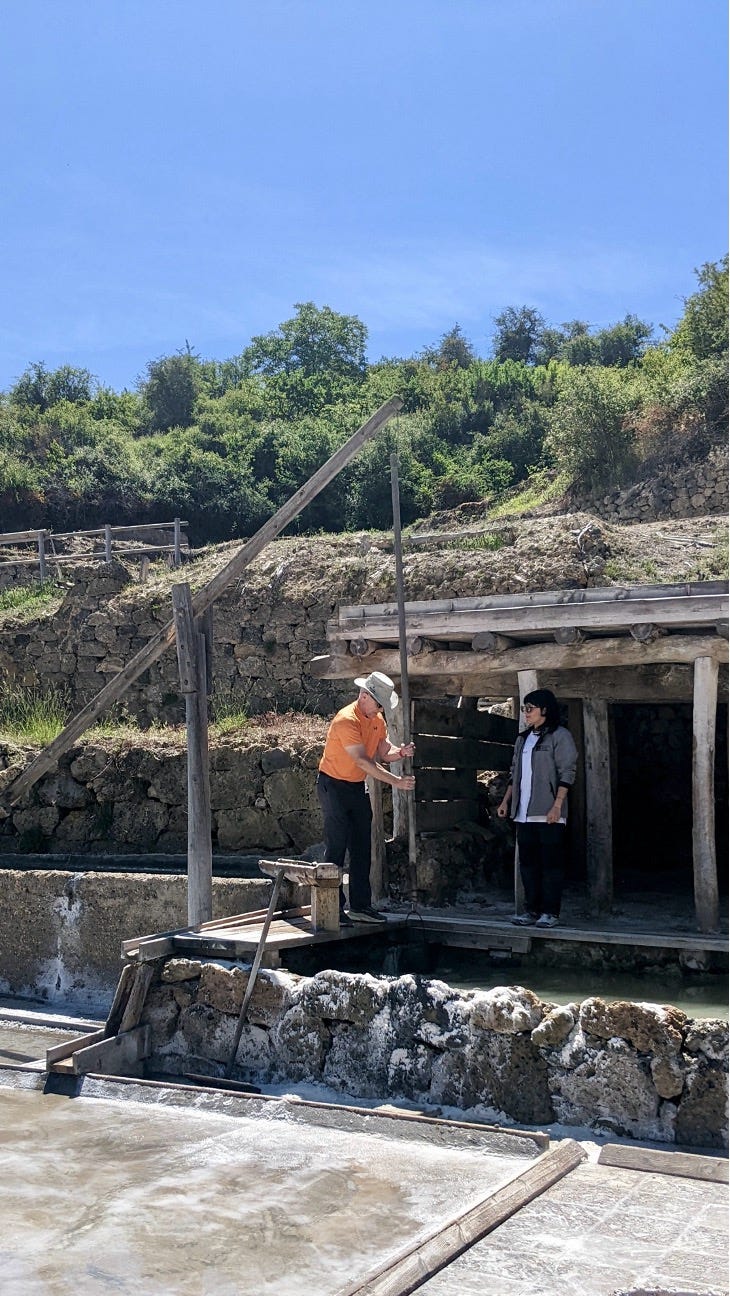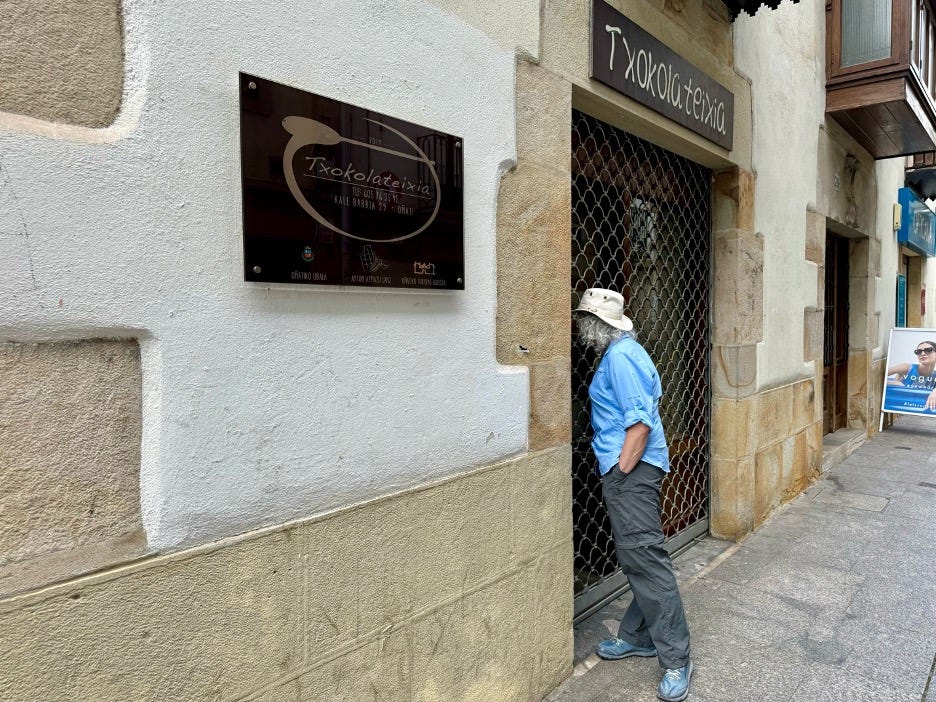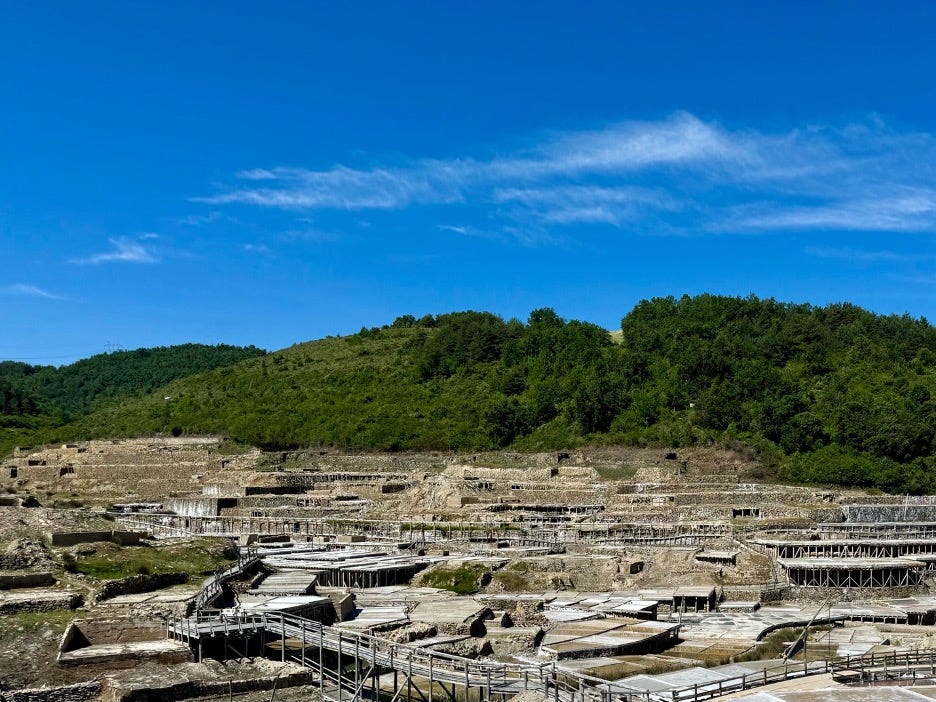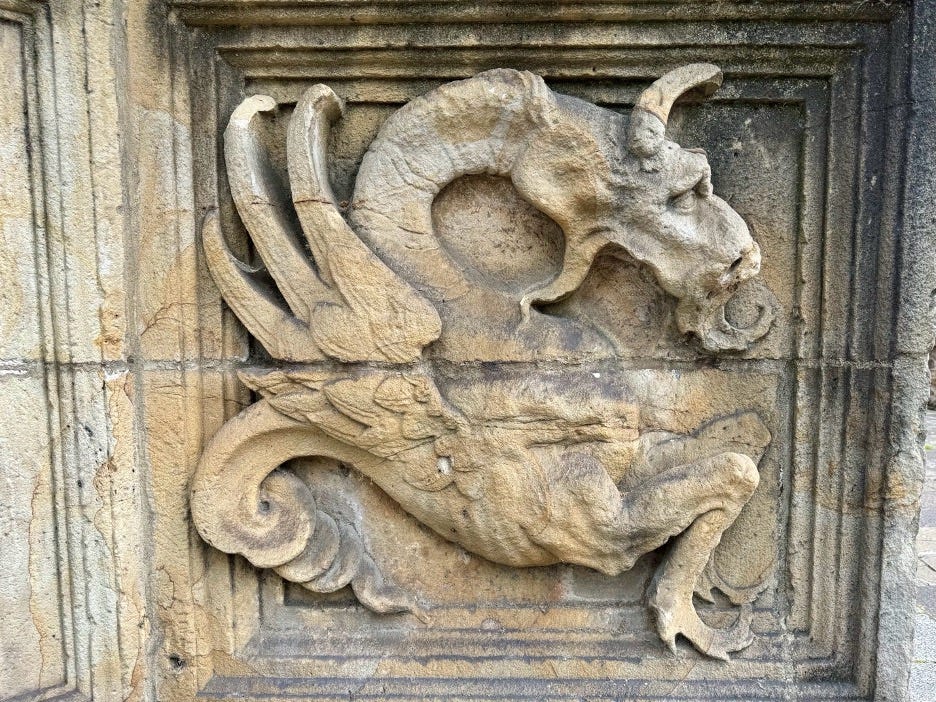Salt
131.11* miles hiked, 10 Cultural Events Attended
If you visit our house, you’ll see that we, as in me (John), has a lot of history and science books. While I would like to decorate with nothing but bookshelves covering every wall, Pam has vetoed that. In fact, she’s nearly on the verge of declaring a new rule: one book in, one book out. I’ve mostly organized the books in chronological order but there’s a couple of shelves where I keep the books I love to read again. Prominent on that shelf are books by Mark Kurlansky, who’s written many books, but I particularly love his books that focus on subjects across history.
My favorite of all is Salt: A World History. The chemical NaCl is ubiquitous today on our tables and roads in winter, so we don’t think much about it. That is unless your food is too salty, or the roads too slippery. Before the advent of chemically producing salt, it was the driving force for much of history. Salt was so valuable that it was used as currency, which is where we get the word salary. Trade routes were founded for salt, and wars were fought over it. I’ve recommended this book for years and to so many people. Its historical breadth is covered with a light touch that teaches and entertains at the same time. I’m sure you will love it. If you don’t, I don’t know if we can be friends. (Just kidding!)
When our tour company, Pura Aventura, suggested visiting the Valle Salado de Añana (Añana Salt Valley), I couldn’t say yes fast enough. Kurlasnky’s descriptions of how salt was mass produced before chemistry around the world is fascinating. In this little valley, salt has been made by hand continuously for over 7,000 years. Eons ago, the valley was a dried-up sea, and with the crashing of the tectonic plates created a huge salt deposit underground, which springs now run though. The brine produced is seven times saltier than the oceans. Salt farming is quite simple. Move the brine to a hot flat area, swish the water around to encourage salt concentration through evaporation, and collect the remaining salt. It’s hot and heavy work. The Valle Salado de Añana web site has a lot more information.
The other day, I lamented the on-the-ropes town of Gallipienzo which needs to find a way to harvest tourists to save the town. Early in the 20th century, manual salt production died out and the salt works were left to rot, as was the town of Añana. In 2009, the government restored the works, build infrastructure to support tourism, and it’s a beautiful example of saving a rural area. They’ve also done a lot of historical and scientific research so the tour covers all aspects in a thoughtful way.
We started the English tour with a very good guide, and there were only eight of us on the tour, so I was looking forward to asking a lot of questions and taking photos. After she gave us the ten-minute overview and we are walking down the pathway, we heard shouting behind us. A group of 18 very corpulent and very ancient Germans are staggering down the path, led by an equally large woman, their tour guide, saying they were part of the tour. Jerk Guide forced her way through us, alternating hollering in German at the barely moving people to gather around and arguing in Spanish and English with our guide.
Our poor guide was trying to tell this woman that this was not her tour, but Jerk Guide would not leave. We are now blocked in by the living dead, so our guide has no choice. Just as Jerk Guide plants herself directly beside our guide, the very nice Scottish lady behind us says “God damn Germans, always invading!” That exquisite quip nearly caused Pam and I to blow a kidney trying to hold in laughter because we wanted that burn to fester in the air as long as possible.
Alas, Jerk Guide was impervious to shame. Our guide is resigned to our fate, so she says the next sentence and Jerk Guide interrupts her to translate what she said in German. Jerk Guide is speaking into a wireless microphone to the earpieces of the nearly comatose group, at twice the volume of our tour guide. At this, our tour guide has had it and sharply tells her to not interrupt her anymore. The three French, two Scots, and two Americans of the original group are now allies and are now glaring at all the somnolent Germans. We silently agree to close ranks and keep a protective blockade around our tour guide.
Jerk Guide is oblivious to the brewing storm, but one perceptive tottering German realizes they have a problem. Some words go back and forth in German and Jerk Guide tones it down for the rest of the tour. Our guide still did a wonderful job, but it meant that I didn’t have time to take decently composed pictures. If I had stopped an unsteady oldster would have surely bump into me and knocked me into the weirdly fragile brine channel system bringing ruin to everything the site offers. Thus, I was unwilling to potentially cause an international incident.
Pam did receive a shock in the middle of the tour. When our guide asked for a volunteer, your intrepid reported jumped at the chance. My thinking was if we let one of the shuffling Germans do it, we’d still be waiting in the valley for them to get there, with us slowly turning to salt. In truth, I was really interested in the process after Kurlansky’s book, so wanted to do anything they would let me do.

After the tour, we had a nice time talking to Celia and her husband. They are retired educators and are spending the next six months caravaning around Europe. They are paying an average of €20-€25 for most of their sites, which is far cheaper than the US. Also, caravans in Europe, trailers to us Yanks, are relatively small. Tongue in cheek, I estimate that three caravans would fit into your average American camping trailer.
After the tour and chat, we headed to Oñati, a town deep in the middle of the highest mountains in Basque Country. We’d arrived after 2:00 PM, so the siesta time was in full swing, which meant our hotel wasn’t open, and we hadn’t really scouted out any hikes. Deciding we could use some tapas we head to the city center and walk around. Finding a restaurant with outdoor seating, we were fortunate to sit down at a table next to who we called “Los acaldes de este calle” (the mayors of this street).
These two older gentlemen squared us away on how to get our order in as the restaurant was about to close and they didn’t want us to go hungry. They knew every single person who walked by, and everyone came over to pay their respects in both Basque and Castellan. When we got our drinks, I toasted their health and they both quietly nodded. Between the constant deference of the passersby and the way they nodded at me, it felt like we were under the protection of the “made” men. They weren’t gangsters but maybe the beer got to me this afternoon.
Side note: Castellan is the main dialect of Spanish across Spain and what we speak in the Americas. Other dialects of Spanish are Catalan and Gallego. Basque is well, Basque. Its the only Paleo-European language spoken in Europe and is not related to any other modern language, which are Indio-European in the language family taxonomy. If you want to know more about these fascinating people and their language, I highly recommend Mark Kurlansky’s The Basque History of the World: The Story of a Nation. Kurlansky is one prolific, and excellent, author!
We could see that Oñati was a decent size town, so we decided to walk around and make that our hike. Passing an old large building, we saw a door to the courtyard was open, so we poked our head in. It turned out to be the Sancti Spiritus Unibertsitatea (Universidad del Espíritu Santo), started by a papal bull in 1540. The building itself is one of the most notable Renaissance buildings in Basque Country.
The above photo is disturbing. It’s some form of goat dragon and I’d love to know the real meaning. Since this is on the university building maybe it’s a warning to slacker students that this is your fate if you don’t study? The curly pig tail is weird as well. Maybe this is just nightmare fuel?
We meandered over to the tourism office and on the window of the building was a map of the town. Concentrating on the map and the significant buildings listed, Pam and I are bent over close to it, when we have the bejesus scared out of us. A lady from the tourist office had opened the door to our left and said, “You can come in, we are open.” She immediately felt bad, but we thought it was hysterical. Since it was the middle of siesta time, we never thought to see if the door was unlocked.
As we laughed our way into the office, the other lady behind the desk said, “Welcome to Basque Country. Our traditional way of greeting people is to scare them.” We got a wonderful overview of Oñati and lots of advice on where to go and what to see. She had brochures and websites for everything. The most interesting factoid I’ll relate is that Oñati is the first non-tourist town we have stayed in. It’s a manufacturing hub, so most people work in industry, with tourism second. This was surprising because Oñati is surrounded by beautiful mountains and streams.
The first place we wanted to visit was the Monasterio de Santa Clara de Bidaurreta, an active monastery for the nuns of Poor Clares (Order of Saint Clare), a Franciscan branch. They give tours, but at the tourist office we were told that the nuns “seem to run on their own schedule so either they are open or not.” We walked up and it turned out to be an “or not” day so we didn’t get to see anything other than the outside and the entry way.
The second key place we had to go was the chocolate museum. If Purple Crayon members learned that Pam had been to a city with a chocolate museum and didn’t go, they would drum her out of PC very quickly. The museum opened at 5:00 PM (the end of siesta time), and we were there five minutes before it opened, natch.

Back in the 17th century, people with connections to Oñati in the New World, sent back cocoa seeds to the city and they started making chocolate. As business grew, more chocolate factories started until in the 1950’s there were 60 chocolate factories in the city. Not bad for a city of between 7,000 and 8,000 people at that time. Today, there is only one chocolate factory that doesn’t offer tours. The museum itself is a single room, but we enjoyed it and now have a large bag of chocolate bars. Real Basque chocolate is less sweet than American chocolate and isn’t engineered to keep you eating it even though you don’t want to. I like it very much.
We poked around a little more and bought groceries for a hike tomorrow, but decided that since it was after 6:00 PM, we would hang out at the hotel, EtxeAundi, a mile outside of town. It’s a nice place and we’d stay there again. It’s rated a two-star hotel, which is set by the government. Here’s an explanation to the star differences for Andalucia, but those are the standard across Spain. It all has to do with corridor sizes, parking, reception hours, and so on.
As the hotel and restaurant has an excellent 4.6-star rating on the internet rating sites, we opted to eat there. The server was great and the food even better. Vegetarians beware: they had roasted suckling lamb thigh on the menu so there was no way I was passing that up!

Thank you for giving me the opportunity to write about our days!




I love that you linked to a local bookstore in Asheville! I’m putting Salt on my reading list.
I laughed my way through this entry! Those damn invading Germans! You are really great writer John! Glad you didn't turn to salt.